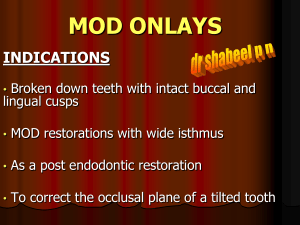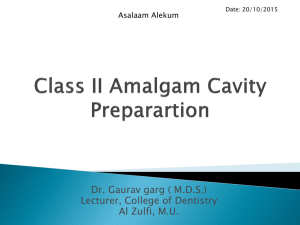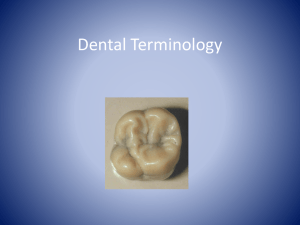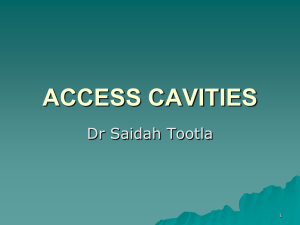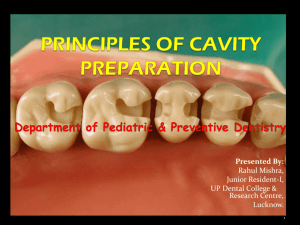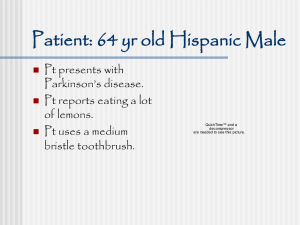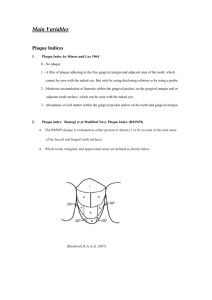Class 2
advertisement
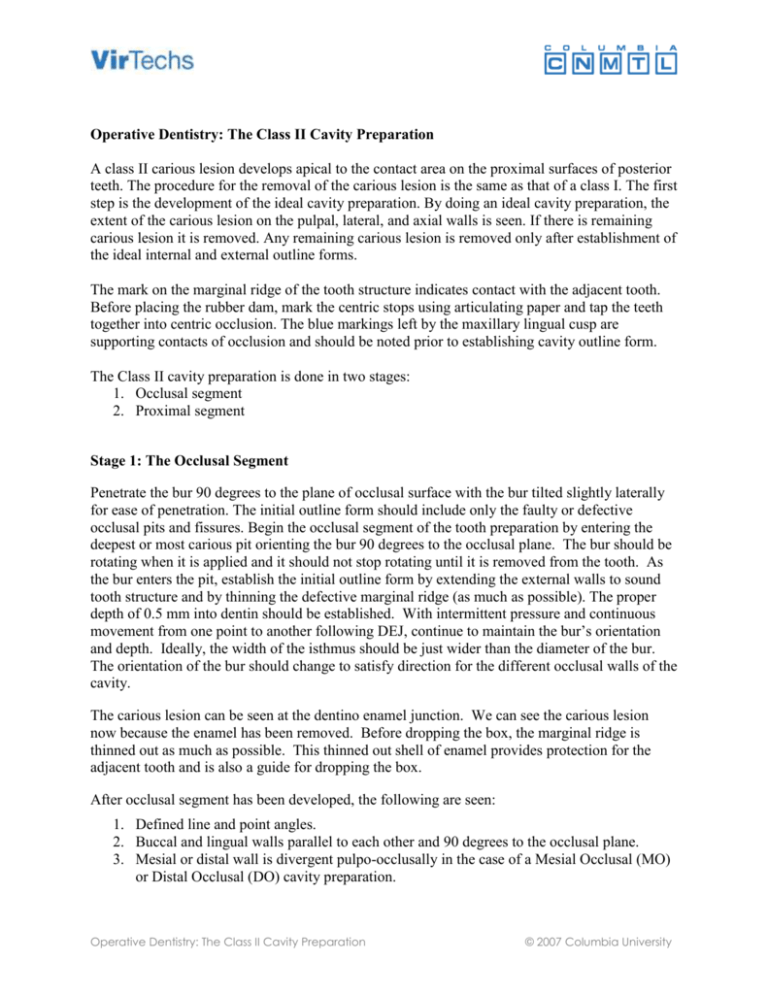
Operative Dentistry: The Class II Cavity Preparation A class II carious lesion develops apical to the contact area on the proximal surfaces of posterior teeth. The procedure for the removal of the carious lesion is the same as that of a class I. The first step is the development of the ideal cavity preparation. By doing an ideal cavity preparation, the extent of the carious lesion on the pulpal, lateral, and axial walls is seen. If there is remaining carious lesion it is removed. Any remaining carious lesion is removed only after establishment of the ideal internal and external outline forms. The mark on the marginal ridge of the tooth structure indicates contact with the adjacent tooth. Before placing the rubber dam, mark the centric stops using articulating paper and tap the teeth together into centric occlusion. The blue markings left by the maxillary lingual cusp are supporting contacts of occlusion and should be noted prior to establishing cavity outline form. The Class II cavity preparation is done in two stages: 1. Occlusal segment 2. Proximal segment Stage 1: The Occlusal Segment Penetrate the bur 90 degrees to the plane of occlusal surface with the bur tilted slightly laterally for ease of penetration. The initial outline form should include only the faulty or defective occlusal pits and fissures. Begin the occlusal segment of the tooth preparation by entering the deepest or most carious pit orienting the bur 90 degrees to the occlusal plane. The bur should be rotating when it is applied and it should not stop rotating until it is removed from the tooth. As the bur enters the pit, establish the initial outline form by extending the external walls to sound tooth structure and by thinning the defective marginal ridge (as much as possible). The proper depth of 0.5 mm into dentin should be established. With intermittent pressure and continuous movement from one point to another following DEJ, continue to maintain the bur’s orientation and depth. Ideally, the width of the isthmus should be just wider than the diameter of the bur. The orientation of the bur should change to satisfy direction for the different occlusal walls of the cavity. The carious lesion can be seen at the dentino enamel junction. We can see the carious lesion now because the enamel has been removed. Before dropping the box, the marginal ridge is thinned out as much as possible. This thinned out shell of enamel provides protection for the adjacent tooth and is also a guide for dropping the box. After occlusal segment has been developed, the following are seen: 1. Defined line and point angles. 2. Buccal and lingual walls parallel to each other and 90 degrees to the occlusal plane. 3. Mesial or distal wall is divergent pulpo-occlusally in the case of a Mesial Occlusal (MO) or Distal Occlusal (DO) cavity preparation. Operative Dentistry: The Class II Cavity Preparation © 2007 Columbia University 4. All defects and carious lesions are removed and walls are placed in sound dentino-enamel junction. 5. All unsupported enamel rods are removed and all walls are finished. 6. All margins are smooth and curved. 7. The marginal ridge is thinned out as much as possible and gives a clear view to access the proximal box. 8. The dentino-enamel junction is visible and clear. 9. Resistance principles are followed when walls are curved and extend around the cusps. 10- Margins are placed on smooth and sound tooth structure. Step 2: The Proximal Segment Due to the morphological shape of the tooth and the contact area, the bucco-proximal wall on the manidibular molar makes an acute angle with the gingival floor and the linguo-proximal wall makes a less acute angle. The initial step in preparing the proximal segment is to place the cutting end of the bur on the DEJ (1/3 in dentin and 2/3 in enamel). Pressure is directed gingivally and lightly toward the enamel shell to keep the bur against the proximal enamel. While the bur is moved facially and lingually along the DEJ, it should be oriented according to the proximal wall directions, occlusopulpally. The bur should also be oriented correctly proximo-axially to visualize the complete mesio-facial and mesio-lingual margins at right angles to the proximal surface. The gingival margin should be extended gingivally to clear the adjacent tooth by 0.5 mm and to remove the entire carious lesion. A slot has been prepared, which is partly in enamel and partly in dentin. The slot is diverging gingivally to ensure that the facio-lingual dimension at the gingival is greater that that at the occlusal. At this stage a low speed handpiece is used to define and finish the box. With the high speed, make two cuts extending toward and perpendicular to the proximal surface to weaken the remaining enamel that can be removed. After the proximal segment is developed, the following are seen: 1. The bucco-proximal and linguo-proximal walls are 90 degrees to the tangent of the tooth structure. 2. The bucco and linguo proximal walls are parallel to the enamel rod direction. 3. The bucco-proximal wall makes an acute angle with the gingival floor and the linguoproximal makes a less acute angle 4. The flare or divergence angle is 90 degrees to the tangent of the tooth. 5. The axial wall is convex in the horizontal section. 6. The axial wall is 0.5-0.8 mm into dentin. 7. The reverse curve preserves the triangular ridge and facilitates the formation of a 90 degree angle between the proximal walls and the tangent of the proximal surface. 8. The occlusal and proximal segment flow together smoothly. Operative Dentistry: The Class II Cavity Preparation Page 2 of 3 Use of Hand Instruments At this stage hand instruments are used to remove ledges and any unsupported enamel from the bucco proximal and lingual proximal walls. Be certain to hold the instrument parallel to the wall. Do not tilt the instrument or excess flare or a bevel will develop. Hold the hatchet parallel to the wall and if there is any unsupported enamel, it will be removed. The instrument should be held parallel to the wall that is being worked on and 90 degrees to the tangent of the tooth structure. Notice the unsupported enamel that was removed. Be sure the axial wall and gingival walls are smooth. Always use the instrument from the bevel side to the non-bevel side. Place the primary cutting edge against the gingival floor and the secondary cutting edge against the axial wall so everything can be done in one stroke. Turn the instrument around for the other side. At the bucco-axial line angle carefully remove any ledges. Do the same for the lingual axial line angle and the axial wall. Use a gingival margin trimmer for planing the gingival cavo surface margin. By planing we develop a small bevel and all unsupported enamel is removed. The gingival margin trimmer is also used to round the pulpal axial line angle. Rounding the pulpal axial line angle decreases the stress on the tooth structure and the amalgam restoration. To review the occlusal segment was developed and the pulpal floor placed approximately 0.5 mm into dentin. All walls were connected with a smooth curve and there are no catches in the groove area. There is now smooth and continuous flow of the preparation. The reverse curve was established. The axial wall was rounded to follow the external outline of the tooth structure and is 0.5-0.8 mm into the dentin. The buccal proximal wall is 90 degrees to the cavo surface margin of the tooth structure; the lingual wall is 90 degrees to the tangent of the tooth structure. There is an acute angle at the bucco proximal and linguo proximal walls. The gingival cavo surface margin was planed and unsupported enamel removed. The Class 2 cavity preparation is complete. Operative Dentistry: The Class II Cavity Preparation Page 3 of 3

